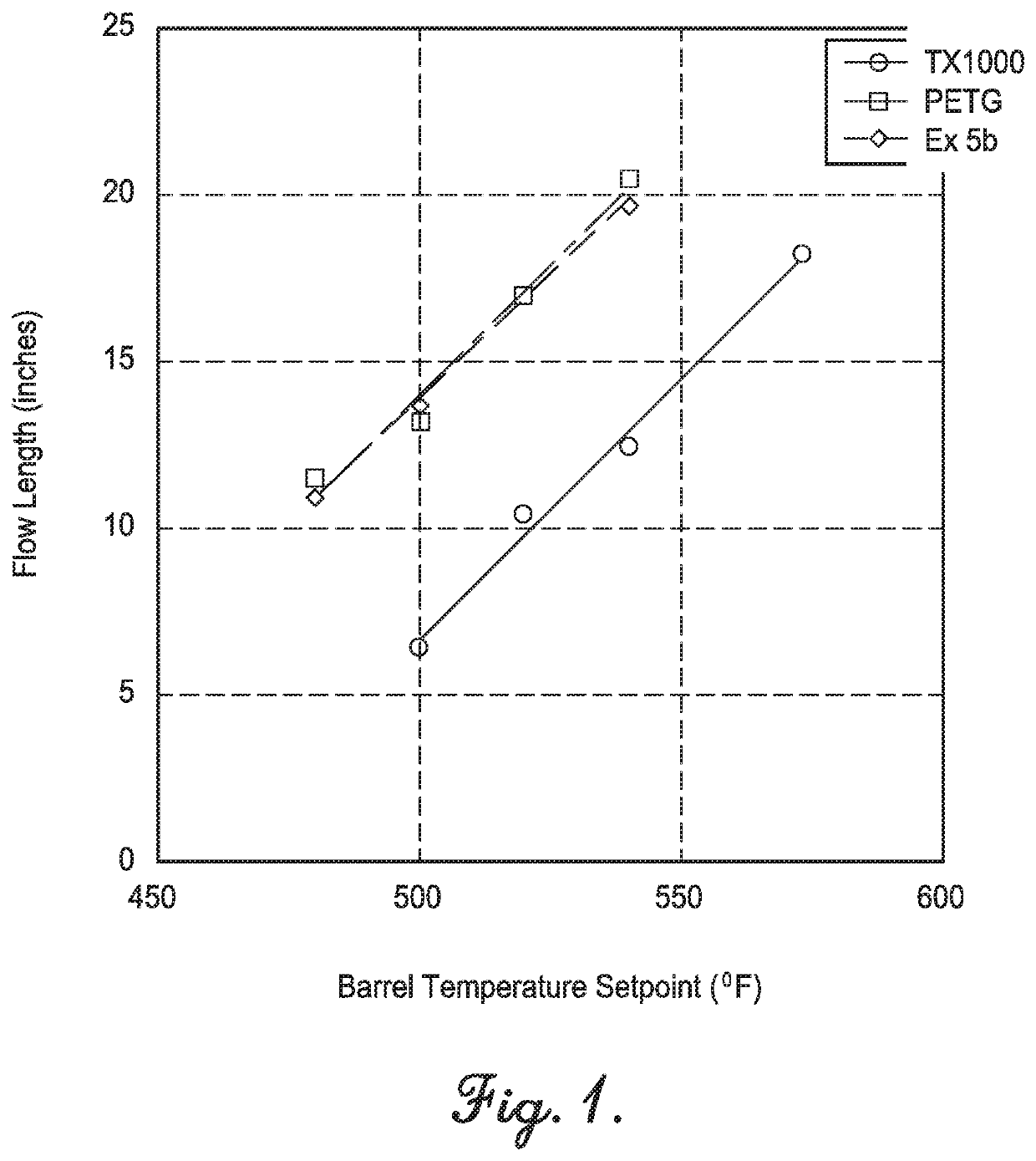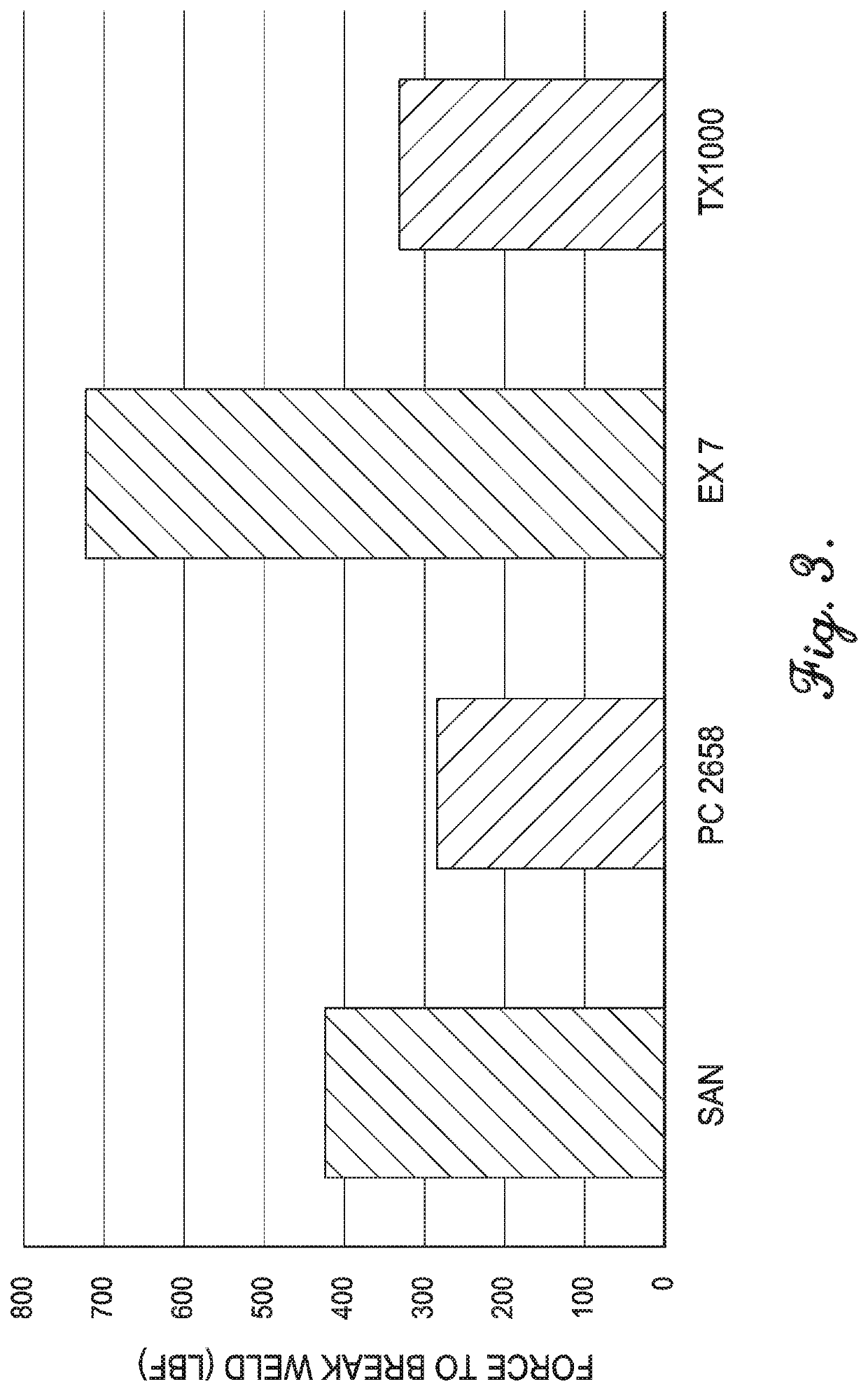Polyester compositions which comprise tetramethylcyclobutandiol and ethylene glycol, with improved catalyst system
a technology of ethylene glycol and tetramethylcyclobutandiol, which is applied in the field of polyethylene glycol compositions made from terephthalic acid, 2, 2, 4, 4tetramethyl1, 3cy, can solve the problems of reducing and affecting the iv rate of materials, so as to achieve good color and mechanical properties
- Summary
- Abstract
- Description
- Claims
- Application Information
AI Technical Summary
Benefits of technology
Problems solved by technology
Method used
Image
Examples
example 1a (
Sn and Ti)
[0308]A mixture of 77.68 g (0.4 mol) of DMT, 42.51 g (0.68 mol) of EG, and 16.61 g (0.12 mol) of TMCD, was placed in a 500-milliliter flask equipped with an inlet for nitrogen, a metal stirrer, and a short distillation column. In addition, 0.22 ml of the Ti catalyst solution (targeting 25 ppm Ti), 0.08 ml of the Sn catalyst solution (targeting 15 ppm Sn), and 1.51 ml of the P stabilizer solution (targeting 40 ppm P) were added to the flask. The flask was placed in a Wood's metal bath already heated to 200° C. The stirring speed was set to 200 RPM at the beginning of the experiment. The contents of the flask were heated at 200° C. for 5 minutes and then the temperature was gradually increased to 275° C. over 240 minutes. The reaction mixture was then held at 275° C. for 20 minutes as the stirrer was slowed down to 100 rpm and a vacuum was gradually applied to 0.3 torr. The temperature of 275° C., vacuum of 0.3 torr, and stirring at 100 rpm was maintained for a total time of...
example 1b (
Ti Only)
[0309]A mixture of 77.68 g (0.4 mol) of DMT, 42.51 g (0.68 mol) of EG, and 16.61 g (0.12 mol) of TMCD, was placed in a 500-milliliter flask equipped with an inlet for nitrogen, a metal stirrer, and a short distillation column. In addition, 0.29 ml of the Ti catalyst solution (targeting 32 ppm Ti) and 1.51 ml of the P stabilizer solution (targeting 40 ppm P) were added to the flask. The choice of 32 ppm Ti was to give the equivalent molar concentration of the total catalyst used in experiment 1a. The flask was placed in a Wood's metal bath already heated to 200° C. The stirring speed was set to 200 RPM at the beginning of the experiment. The contents of the flask were heated at 200° C. for 5 minutes and then the temperature was gradually increased to 275° C. over 240 minutes. The reaction mixture was then held at 275° C. for 20 minutes as the stirrer was slowed down to 100 rpm and a vacuum was gradually applied to 0.3 torr. The temperature of 275° C., vacuum of 0.3 torr, and ...
example 1c (
Sn Only)
[0310]A mixture of 77.68 g (0.4 mol) of DMT, 42.51 g (0.68 mol) of EG, and 16.61 g (0.12 mol) of TMCD, was placed in a 500-milliliter flask equipped with an inlet for nitrogen, a metal stirrer, and a short distillation column. In addition, 0.41 ml of the Sn catalyst solution (targeting 77 ppm Sn), and 1.51 ml of the P stabilizer solution (targeting 40 ppm P) were added to the flask. The choice of 77 ppm Sn was to give the equivalent molar concentration of the total catalyst used in experiment 1a. The flask was placed in a Wood's metal bath already heated to 200° C. The stirring speed was set to 200 RPM at the beginning of the experiment. The contents of the flask were heated at 200° C. for 5 minutes and then the temperature was gradually increased to 275° C. over 240 minutes. The reaction mixture was then held at 275° C. for 20 minutes as the stirrer was slowed down to 100 rpm and a vacuum was gradually applied to 0.3 torr. The temperature of 275° C., vacuum of 0.3 torr, and...
PUM
 Login to View More
Login to View More Abstract
Description
Claims
Application Information
 Login to View More
Login to View More - R&D
- Intellectual Property
- Life Sciences
- Materials
- Tech Scout
- Unparalleled Data Quality
- Higher Quality Content
- 60% Fewer Hallucinations
Browse by: Latest US Patents, China's latest patents, Technical Efficacy Thesaurus, Application Domain, Technology Topic, Popular Technical Reports.
© 2025 PatSnap. All rights reserved.Legal|Privacy policy|Modern Slavery Act Transparency Statement|Sitemap|About US| Contact US: help@patsnap.com



